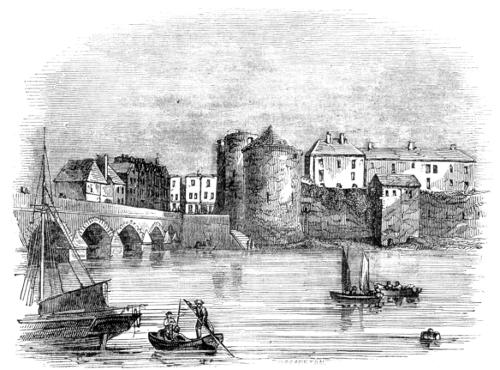THE IRISH PENNY JOURNAL.
| Number 39. | SATURDAY, MARCH 27, 1841. | Volume I. |

THOMOND BRIDGE AND THE CASTLE OF LIMERICK.
There is scarcely in all Ireland a scene which has so manyexciting associations connected with it as that which we havechosen as the pictorial subject for the present number of ourJournal. The bridge is indeed a new one; but it is erected onthe site of that most ancient one which was the scene of somany a hard-fought battle for all that men hold dear; andthe castle—ruined and time-worn, it is true—is the samefortress which served in turn the race by whom it waserected, and, as if partaking of the change which our soil issaid to make in the feelings of all those who settle on it,became the last and most impregnable stronghold of those itwas designed to subdue.
But some of the events connected with this scene—andthese events, too, the most important—though honourable tothe manly character of all concerned in them, and such as allthe members of the great family of the British empire may nowfeel a pride in—are still associated with remembrances which tomany are of a saddening cast, and which require to be softenedby distance or time before they can be distinctly awakenedwithout giving pain—like our country’s music, of whicheven some of the most exhilarating movements have strangetones of sorrow blended with them, which to many temperamentsare too touching if strongly accented. And we do nottherefore regret that in the short notice of Limerick Bridgeand Castle which we have to present to our readers, neitherour plan nor our space will permit us to give any sketch oftheir history but such as may be read by all, if not with pleasure,at least without pain.
The Castle and Bridge of Limerick owe their origin to thefirst Anglo-Norman settlers in Ireland, and were erected tosecure their possessions and facilitate the extension of them.It is probable, however, if not certain, that the site ofthe castle had been previously occupied by a strongholdof the Ostmen or Danes who settled in Limerick in theninth century, and with whom, if they were not its founders,its authentic history as a city at least begins; for the earlierhistorical notices connected with it relate only to its churchor churches.
These churches, with whatever town may have been connectedwith them, were plundered by the Danes as early asthe year 812; and there is every reason to believe that theyfortified the island in the Shannon, or what is now called theEnglish town, with walls and towers very shortly afterwards,as our annalists record the predatory devastations of theDanes of Limerick in Connaught and Meath as early as theyear 843, as well as at various years subsequent. They[Pg 306]were, however, at length conquered, but not removed, by thevictorious arms of Brian Boru, and afterwards Limerick appearsin history only as an Irish city, though its inhabitantswere chiefly of Danish descent. It was here that TurloghO’Brien, king of Munster, received in 1064 the homage ofDonlevy, king of Ulidia; and his son and successor, MurtoghO’Brien, having given Cashel, the ancient metropolis ofMunster, to the church, made Limerick his chief residence andthe capital of the province, from which time it continued to bethe seat of the kings of Thomond or North Munster, whowere hence called kings of Limerick until i